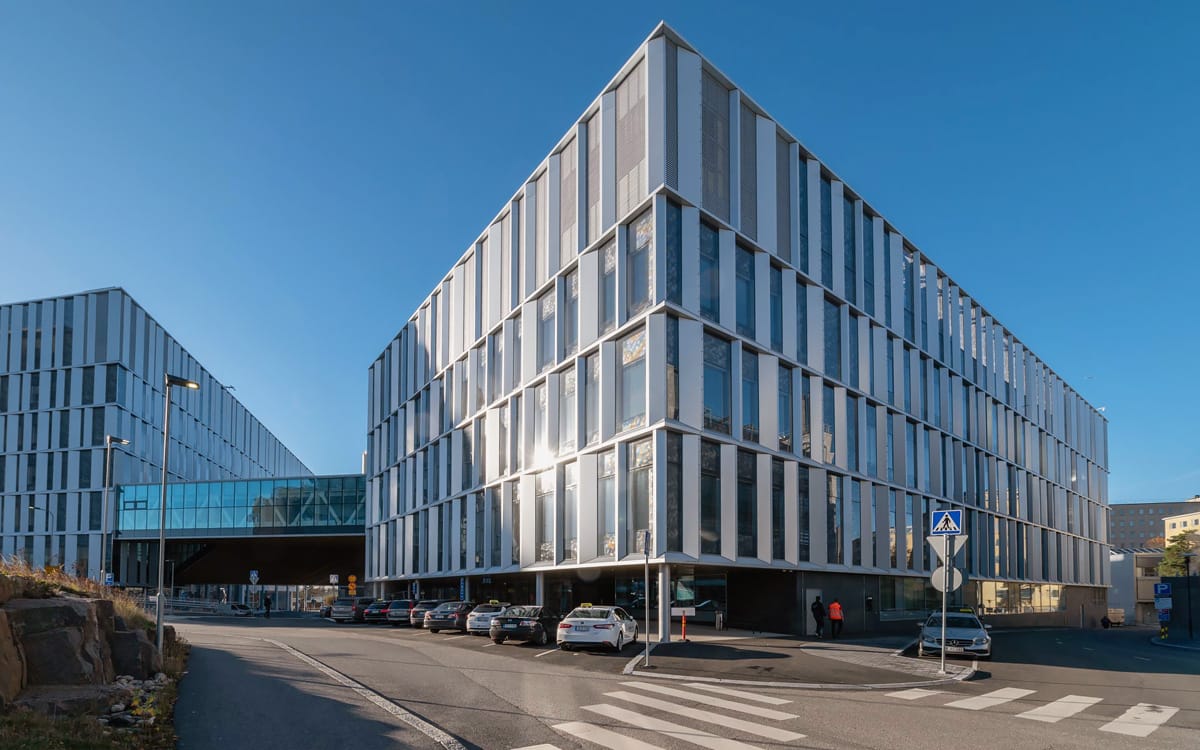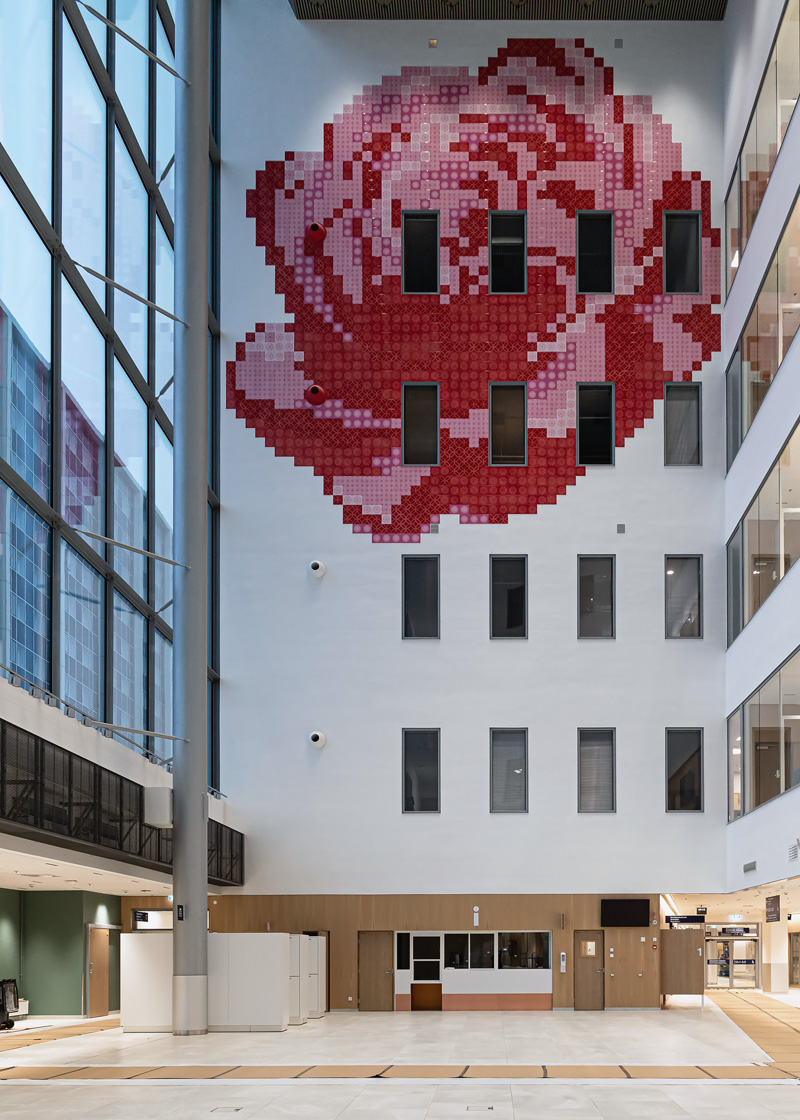The impressive new buildings of the Meilahti Bridge Hospital and Comprehensive Cancer Center rose in the Meilahti Hospital area of Helsinki, on a triangular plot bounded by the Meilahti Tower Hospital, the Department of Oncology and Paciuksenkatu street. The design of the new hospital has been based on a simple and functional structure and flexibility. In the project, special attention has been paid to the building’s energy efficiency, good indoor air quality and versatile utilization of natural light.
The name of the hospital comes from the glass-walled bridge connecting the spaces of the two-part building. In addition to connecting passages, the structurally demanding steel bridge has meeting rooms and a large lounge staircase. The solution was reached because the corridor connecting the buildings could not be built at ground level because of the roadway. The bridge is mainly used by, for example, students of the teaching hospital and relatives visiting the hospital. Hospital patients are transported less often.
The Bridge Hospital was connected to other buildings, tunnel network and hospital technology in the Meilahti hospital area. The building was integrated into the old personnel and building technology tunnel which passed under the new building. Old tunnel was decided to be preserved for cost reasons. The old tunnel was used by other hospitals throughout the construction project. The integration of numerous connection points has been one of the most demanding similar projects that has been implemented in Finland.
Bridge Hospital’s fire safety design
As a project, HUS Bridge Hospital was not only one of the largest and most extensive projects in our company’s history, but also one of the longest-lasting. We started working on the project in March 2016 and finished our work more than six years later. We did most of the fire safety design during the years 2016-2018. The documents required for the building permit were drawn up in 2017, and the building permit application was submitted at the end of the same year.
For us, the project started as a traditional fire safety design. Traditional fire safety design is based on the intended use of the building and predetermined fire load groups, as well as the testing and classification of the fire properties of building components. The fire safety design was carried out “as traditionally done”, i.e. almost entirely according to preset fire classes and numerical values of “dimensioning tables” as until the building permit application was ready. Nowadays a significantly larger part of the fire safety engineering would probably be carried out with performance-based fire safety design using various fire and evacuation simulations as a tool – primarily to ensure safety, of course, but also to find cost savings in structural solutions.
In the case of the safety design according preset numerical values, some applicable solutions had to be made. For example, due to the huge size of the building, special attention had to be paid to the design of a few individual evacuation routes. The bridge between the buildings is not just a simple passageway. Officially it is community gathering space, which has its own influence on the design of the building’s operational and fire safety according the regulations.
In a few details, we used simulations even before the building permit application was completed. The Bridge Hospital was designed in such a way that it is easy to find your way around the building without the need for guiding floor tapes. The implementation is based on three high glass lobbies, which act as a kind of fixed points. We study the behavior of the glass walls of these lobbies with simulating an assumed fire development.
After the original building permit was granted, many details of the plans have been refined with performance-based fire safety design and simulations, and change permits have been applied if it has been necessary. Simulations were performed, for example, in following cases:
- Simulation of a assumed fire development in the ambulance yard. The ambulance yard is located under the bridge connecting the buildings, so we investigated the effect of a possible fire on the structures of the bridge above.
- Simulation of the fire-rated glass of the atriums in lobby spaces. The lobbies rise from the lower floors to the upper ones, and there are hospital spaces on both sides of them, including some patient wards. Initially, the glass structures were designed for fire class EI60, but the simulation proofed that even glass type-approved for fire-resistance grading E15 would be sufficient in terms of fire resistance. However, the hospital’s developer HUS Kiinteistöt Oy wanted to keep the safety level high, so the glass walls were made with glasses approved for fire class E30. Just to be sure.
- The structural effects for the hospital facade of an oil fire in the premises of an emergency power plant.
Alternatives to fire safety structural solutions, especially glass structures, were sought with performance-based fire safety design – also with a view to cost savings. Since the hospital’s lighting was designed to utilize natural light, there are plenty of glass surfaces. More than 5,400 windows have been installed in the building.
Our services in the project
Our services in the Meilahti Bridge Hospital and Comprehensive Cancer Center construction project included:
- fire engineering planning with traditional fire safety design, fire safety plans
- fire safety design based on assumed fire development with simulations and calculations; we mainly studied the effect of fire on various structures, in this project we did not implement evacuation simulations or smoke clearance simulations
- plans for smoke clearance
- fire-technical expert opinions for construction site-specific certification for construction products for which there was no approval procedure, or which differed from the relevant approval
- consulting in fire-technical issues for various designers and contractors
- official approvals for plans
- construction site fire safety planning
- fire safety design of integrated connecting parts (underground spaces, corridors and parking shafts were connected to old underground shafts and tunnels).
Our main memory of this great project is that fire safety was taken care of exceptionally well and based on the best possible knowledge. In many projects the fire consultant’s tasks have ended with the granting of the building permit, but in the Bridge Hospital project, we were closely involved until the very end. Every detail affecting fire safety was verified, every change made to the plans was checked, we answered continuous questions, new opinions were requested all the time, and a lot of simulations were also done. We emphasize that it is very exceptional that the customer wants to take care of the fire safety so well, and that’s why mistakes occur in many other projects during construction. That is why we are confident that Bridge Hospital’s fire safety solutions are certainly in order.
Bridge Hospital in a nutshell
The Bridge Hospital, built between the Meilahti Tower Hospital and the Department of Oncology, replaces the functions of the Töölö Hospital and part of the Department of Oncology and joins the adjacent buildings forming a unified whole with them. Bridge Hospital has been the largest construction project in the history of the Joint Authority of the Helsinki and Uusimaa Hospital District and one of the most demanding and extensive hospital construction sites in the history of Finland.
The Bridge Hospital was a construction project worth a total of 305.5 million euro. Project lasted seven years. The hospital consists of two new buildings and a passage, a bridge, connecting them. The hospital is owned by the Joint Authority of the Helsinki and Uusimaa Hospital District (HUS) and its builder was HUS Kiinteistöt Oy. HUS Kiinteistöt Oy is a wholly owned subsidiary of HUS Helsinki University Hospital. The main contractor was SRV, one of Finland’s largest and most experienced hospital builders.
At the start of the hospital’s operations, the construction project, which went by the name of HUS Siltasairaala (“HUS Bridge Hospital”) during construction, was divided into two operating hospitals, Meilahti Bridge Hospital and Comprehensive Cancer Center. With the new hospitals, a significant part of Finland’s most modern and high-level specialized medical care and special medical expertise will be concentrated in the Meilahti hospital area.
The Bridge Hospital has 58 intensive care beds, 16 operating theaters, 215 beds divided in four wards, 69 day hospital beds, outpatient clinics and other spaces like restaurant and teaching facilities. The volume of the building is more than 350,000 m³, which is equivalent to more than three Parliament House of Finland, and its total area is approximately 71,500 m² – almost the same as seven soccer fields combined! The number of floors of the hospital varies from the five floors in the lowest part of the building to nine floors in the highest part.
More than 3,000 separate rooms have been implemented in the building, some of which are technically very demanding and intended for, among other things, intensive care, surgeries, medical imaging and radiation therapy. The operation and facilities are designed around research and treatment equipment. The starting point for space planning has been to reduce the need to transfer patients, because especially in the case of the trauma center, short distances may save lives.
Meilahti Bridge Hospital on the map
Read more
It is important for both staff and patients that all hospital facilities are safe and enable efficient patient care. The hospital’s fire safety must simply be in the best possible condition, as a fire can seriously damage people, patient data and hospital property. A fire that interrupts the operation of a hospital can cause serious consequences for patient safety long after the fire. A fire can also have extensive effects on the immediate surroundings of the hospital.
Several hospital and nursing facility fires have occurred in Finland over the years. In two out of three cases, the fire is human-caused, either intentionally, by mistake, or by accident. In several intentionally set fires, the culprit has been a psychiatric patient who set fire to the furniture in the patient room. Due to the openness of the hospital premises, there is also a risk of arson.
In one case out of three, the cause is a carelessly used or damaged device. The fire in October 2009 that caused significant material damage to Meilahti Hospital’s operating room and anesthesia department was ignited by disposable electrosurgical pencil that was incorrectly used and dropped in the wrong trash can. Fortunately, there were no fatalities. The fire that broke out at Turku University Central Hospital’s emergency clinic in September 2011 was caused by a short circuit in the connector of the nurse call system in the patient area. Nobody died, but three nurses exposed to the smoke had to be transported for treatment and the fire caused damages of 17.5 million euros.
The risks and fire safety of the hospital environment are affected by the same principles as in other buildings, but the stakes are higher than usual. Evacuation during medical procedures such as surgery can result in death. That’s why prevention is one of the most important factors affecting fire and personal safety in a hospital. For this reason, hospitals invest in continuous staff training and emphasize commitment to fire safety.
If the worst happens, it must be possible to leave the burning hospital safely. That is why the hospital’s fire safety planning focuses exceptionally precisely on e.g. evacuation routes, barrier-free access routes for the rescue service, fire loads, extinguishing equipment, smoke clearance, and limiting the spread of a fire and the toxic smoke gases it produces.
The level of planning for evacuation safety must be very high, because among those fleeing the fire there are often also children and people with reduced functional capacities, such as the elderly, patients with limited movements due to medical procedures or patients who are under strong medication.
It was decided more than 10 years ago to transfer the operation of Töölö Hospital to the Meilahti hospital area. The Bridge Hospital construction project started in the spring of 2015, when the Joint Authority of the Helsinki and Uusimaa Hospital District HUS organized an invitational competition for architectural offices for the new Meilahti hospital building. At that time, the project was called HUS Traumakeskus-syöpäkeskus, “HUS Trauma Center – Cancer Center”. The competition was won by the consortium Team Integrated. The main designer was Matti Anttila from international architecture company AW2 Architects Oy.
In June 2017, a project management contract was signed for the project. The project was started with a half-year development phase, and design solutions were drawn up in cooperation between the builder, future user, designers and contractor. The cooperative project management contract enabled simultaneous planning and construction, which aimed to ensure that the premises of the new building are as up-to-date as possible and meet the needs of future users.
The main and architectural design of the bridge hospital was handled by Team Integrated, the winner of the architectural competition. Consortium included AW2 Architects Oy, Brunet Saunier Architectures S.A., B&M Architects and architecture office Harris-Kjisik. The huge size of the building caused its own challenges for the design, as did its location. The new building was placed in the middle of a working hospital area and even in the middle of Helsinki.
The construction site of Bridge Hospital started in January 2018 with demolition, earthworks and excavation works. The foundations were made in May 2018 and the element installations of the frame phase started in September of the same year. The construction time of the project was exceptionally long, as the challenges were especially the location, the cramped construction site and the connection to the tunnel network and hospital technology of the other properties in the Meilahti hospital area. The aim was to avoid disturbing the operating hospitals, so for example massive excavation work with explosions in the middle of the operating hospitals and their vibration-sensitive equipments was demanding.
The building was completed on time, despite new surprising challenges, such as the corona pandemic which forced office workers to work remotely. Of course, there were cases of illness at the construction site, but the infection rates were always so moderate that there was no need to stop the entire construction work. The construction work was completed in June 2022, and the hospital was handed over to the Joint Authority of the Helsinki and Uusimaa Hospital District.
The premises of the new Comprehensive Cancer Center were opened to the first patients on the January 3rd 2023. Meilahti Bridge Hospital opened January 23rd 2023.
- nearly 5,000 truckloads of rock were quarried from the area
- up to 300-400 elements were installed per week
- there were up to seven cranes at the site at the same time
- the building has 3,138 separate rooms
- 5,808 doors or hatches were installed in the hospital; 5,403 windows were installed
- 61,167 kilograms of lead sheet have been used for the radiation protection of the premises, which corresponds to the weight of approximately 13 elephants
- 5,021 people from 854 companies were introduced to the site
- up to 517 people worked at the site at the same time (in November 2020), construction work took 1236 man-years
- the construction waste sorting rate during the construction work, including demolition waste, has been 91% and the waste utilization rate 96.3%.










